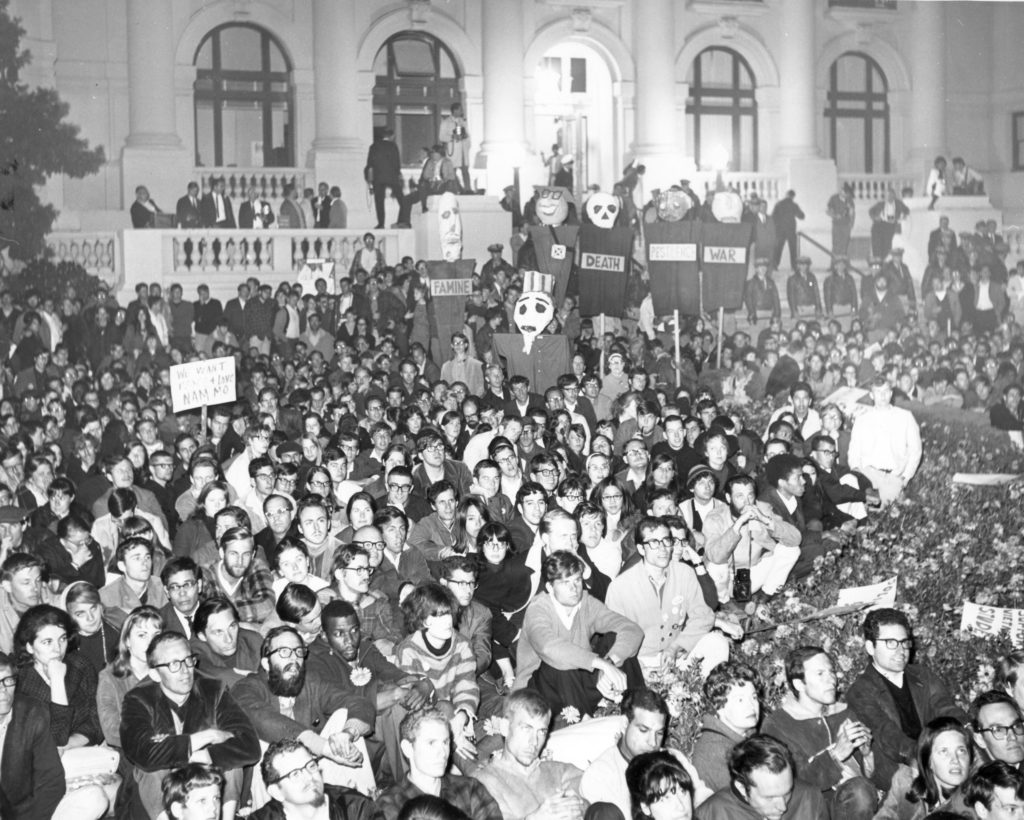Sixties Museum, Cultural Center, and Historical Society

The thing the Sixties did was show us the possibilities and the responsibility that we all had. It wasn’t the answer. It just gave us a glimpse of the possibility. We were all on this ship in the Sixties, a ship going to discover the New World. —John Lennon
Among the projects of California I CAN, rooted deeply in the personal and professional history of Malcolm and his friends, is a proposal to create a Museum, Cultural Center, and Historical Society for the Sixties. Why do we need such an institution? The idea sprang out of a meeting in the Earth Island Institute’s conference room regarding an anthology of Berkeley writings that California ICAN is putting together. The purpose of the anthology is to examine what makes Berkeley so remarkable, why it has long nurtured world-class creativity in the arts and daring innovation in the way we lead our personal lives and conduct our civic affairs. Why in these generally discouraging times does a stream of utopian idealism still infuse much of Berkeley’s life, informing personal decisions and civic actions alike? And as Berkeley changes, how do we keep that spirit alive?
Many of those present spoke of the Sixties as a factor that energized Berkeley and continues to do so. The decade was a period of social experimentation, of engagement, and of new ideas that we were sure would lead to a better world. For many, the Sixties were a liberation and an inspiration. It could be said that the Sixties were our modern-day Renaissance and Berkeley our Florence.
But while those of us who lived through the Sixties (especially those who inhaled the Sixties culture) luxuriated in the memory of that era, the younger people in the conference room were dismissive and even annoyed by the nostalgic glorification of a time long before they were born. They were, moreover, shockingly ignorant of the people and issues that arose at that time and have shaped so much of modern life. They understood the Sixties in terms of clichés and symbols. The power of the ideas that motivated us was lost to them. Looking around the room, it was obvious that the living witnesses to this thrilling and transformative era would soon be gone. Unless something were done, the beauty, wisdom, hopefulness, and restorative powers of that time would soon be forgotten. All that would remain would be a few images locked in degrading clichés. Bummer.
The Sixties were not all “peace and love,” of course; it was a complex time, with faults, betrayals, and limitations that would do those who lived it a world of good to understand. The realities of this era were a mixed bag, but the underlying values still resound in our lives, our culture, and our institutions. Despite our failings, what we accomplished was remarkable. At the close of the Fifties, the South still had Jim Crow Laws that separated whites from blacks; DDT was used regularly; rivers were being dammed, wetlands drained, and historic structures were easily destroyed; women were routinely relegated to lower paying jobs; same sex relationships were illegal, as were abortions; suburban life was accepted as desirable and brought with it thirsty green lawns and the increasing need for automobiles; smog enveloped our cities; and nowhere in America could a good cup of coffee be found. The Sixties changed much of this and more.
But changing the world is hard work, and while our generation made a good start, it will take more than one generation to finish the task. On November 8, 2018, California ICAN held an event at the David Brower Center in Berkeley to explore the lessons of the Sixties. Before a capacity crowd, including a couple of dozen young activists to whom we provided complimentary tickets, a stellar panel of prominent figures from the Sixties addressed the question: “What should we bring with us from this tumultuous era that will be valuable in the coming decades, what should we leave behind?”
Speakers included Jesse Arreguin, Mayor of Berkeley; Kenneth Brower, author and environmentalist; Peter Coyote, actor and cultural activist; Frye Gaillard, historian and author of A Hard Rain: America in the 1960s; David Lance Goines, printer and Free Speech Movement participant; Susan Griffin, poet and essayist; David Harris, draft resistor and author; Adam Hochschild, author and publisher,; Anna de Leon, singer and social activist; Wes (“Scoop”) Nisker, radio commentator and Zen teacher; Arnold Perkins, community leader and youth mentor. In the audience were still other significant Sixties activists, including author Fritjof Capra,marijuana legalization advocate and author Ed Rosenthal, author and educator Herb Kohl, photographer Harold Adler, draft resistor and cultural gadfly Lee Swenson, filmmaker Judy Ehrlich, restauranteur Narsai David, and many others. For a video of this conference, please go to this link: https://vimeo.com/316202772
